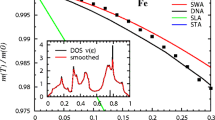Abstract
We consider the electron-phonon interaction in the framework of dynamic spin-fluctuation theory and obtain an expression for the self-energy part that depends explicitly on the spin fluctuations and lattice vibrations. We illustrate the theoretical results with the example of iron. We show that the effect of phonons on temperature dependence of the magnetic characteristics of metals is appreciable but not as large as in the static single-site approximation of the spin-fluctuation theory and spin dynamics using classical Hamiltonians.
Similar content being viewed by others
References
T. Moriya, Spin Fluctuations in Itinerant Electron Magnetism, Springer, Heidelberg (1985).
Y. Kakehashi, Modern Theory of Magnetism in Metals and Alloys, Springer, Berlin (2012).
N. B. Melnikov and B. I. Reser, Dynamic Spin-Fluctuation Theory of Metallic Magnetism, Springer, Berlin (2018).
G. V. Paradezhenko, N. B. Melnikov, and B. I. Reser, “Debye-Waller factor in neutron scattering by ferromagnetic metals,” Theor. Math. Phys., 195, 572–583 (2018).
D. J. Kim, New Perspectives in Magnetism of Metals, Kluwer, New York (1999).
V. I. Grebennikov, “Influence of thermal oscillations of atoms on the electronic properties of transition metals,” Phys. Metals Metallogr., 64, 59–69.
E. A. Turov and V. I. Grebennikov, “Magnetism and transport phenomena of transition metals in spin fluctuation theory of itinerant electrons,” Phys. B, 149, 150–155 (1988).
J. Yin, M. Eisenbach, D. M. Nicholson, and A. Rusanu, “Effect of lattice vibrations on magnetic phase transition in bcc iron,” Phys. Rev. B, 86, 214423 (2012).
B. Alling, F. Körmann, B. Grabowski, A. Glensk, I. A. Abrikosov, and J. Neugebauer, “Strong impact of lattice vibrations on electronic and magnetic properties of paramagnetic Fe revealed by disordered local moments molecular dynamics,” Phys. Rev. B, 93, 224411 (2016).
A. V. Ruban and O. E. Peil, “Impact of thermal atomic displacements on the Curie temperature of 3d transition metals,” Phys. Rev. B, 97, 174426 (2018).
B. L. Gyorffy, A. J. Pindor, J. Staunton, G. M. Stocks, and H. Winter, “A first-principles theory of ferromagnetic phase transitions in metals,” J. Phys. F: Met. Phys., 15, 1337–1386 (1985).
B. T. Willis, “Lattice vibrations and the accurate determination of structure factors for the elastic scattering of X-rays and neutrons,” Acta Cryst. A, 25, 277–300 (1969).
L. P. Pathak, J. Prakash, V. P. Singh, and M. P. Hemkar, “Debye-Waller factors of α-iron and sodium: II.Willis’s anharmonic theory,” Aust. J. Phys., 28, 707–713 (1975).
W. L. McMillan, “Transition temperature of strong-coupled superconductors,” Phys. Rev., 167, 331–344 (1967).
J. J. Hopfield, “Angular momentum and transition-metal superconductivity,” Phys. Rev., 186, 443–451 (1969).
D. A. Papaconstantopoulos, L. L. Boyer, B. M. Klein, A. R. Williams, V. L. Morruzzi, and J. F. Janak, “Calculations of the superconducting properties of 32 metals with Z ≤ 49,” Phys. Rev. B, 15, 4221–4226 (1977).
A. L. Kuzemsky, A. Holas, and N. M. Plakida, “Self-consistent theory of the electron-phonon interaction in transition metals and their compounds,” Phys. B+C, 122, 168–182 (1983).
W. John, “Elektron-Phonon-Wechselwirkung,” in: Ergebnisse in der Elektronentheorie der Metalle (P. Ziesche and G. Lehmann, eds.), Springer, Berlin (1983), pp. 375–401.
B. I. Reser and N. B. Melnikov, “Problem of temperature dependence in the dynamic spin-fluctuation theory for strong ferromagnets,” J. Phys.: Condens. Matter, 20, 285205 (2008).
G. V. Paradezhenko, N. B. Melnikov, and B. I. Reser, “Method of continuation in a parameter for a nonlinear system of scalar and functional equations,” J. Comput. Math. Math. Phys. (to appear).
N. B. Melnikov, B. I. Reser, and V. I. Grebennikov, “Extended dynamic spin-fluctuation theory of metallic magnetism,” J. Phys.: Condens. Matter, 23, 276003 (2011).
J. Crangle and G. M. Goodman, “The magnetization of pure iron and nickel,” Proc. Roy. Soc. London Ser. A, 321, 477–491 (1971).
V. L. Moruzzi, J. F. Janak, and A. R. Williams, Calculated Electronic Properties of Metals, Pergamon, New York (1978).
B. I. Reser, “Calculation of the magnetic properties of Fe, Co, and Ni with account taken of the real band structure and spin fluctuations,” J. Phys.: Condens. Matter, 11, 4871–4885 (1999).
N. B. Melnikov, G. V. Paradezhenko, and B. I. Reser, “Spin-density correlations and magnetic neutron scattering in ferromagnetic metals,” Theor. Math. Phys., 191, 602–619 (2017).
V. J. Minkiewicz, G. Shirane, and R. Nathans, “Phonon dispersion relation for iron,” Phys. Rev., 162, 528–531 (1967).
K.-H. Hellwege and J. L. Olsen, eds., Metals: Phonon States. Electron States and Fermi Surfaces. Phonon States of Elements. Electron States and Fermi Surfaces of Alloys (Landolt-Börnstein. Num. Data Funct. Relat. in Sci. Tech. New Ser., Vol. 13A), Springer, Berlin (1981).
C. W. Haworth, “Measurement of the Debye-Waller temperature factor for silver and α-iron,” Philos. Mag., 5, 1229–1234 (1960).
P. Debrunner and R. Morrison, “Mössbauer scattering of 14.4-keV gamma rays from Fe as a function of temperature,” Rev. Modern Phys., 36, 463 (1964).
Acknowledgments
The authors are grateful to the referee for the useful comments.
Author information
Authors and Affiliations
Corresponding authors
Ethics declarations
Conflicts of interest. The authors declare no conflicts of interest.
Additional information
This research was performed within the state assignment of the Ministry of Science and Education of Russia (Theme “Electron” No. AAAA-A18-118020190098-5) and was supported in part by a program of the Ural Branch of Russian Academy of Sciences (Project No. 18-2-2-11).
Prepared from an English manuscript submitted by the authors; for the Russian version, see Teoreticheskaya i Matematicheskaya Fizika, Vol. 201, No. 1, pp. 137–148, October, 2019.
Rights and permissions
About this article
Cite this article
Melnikov, N.B., Paradezhenko, G.V. & Reser, B.I. Effect of Phonons on the Magnetic Characteristics of Metals at Finite Temperatures. Theor Math Phys 201, 1531–1540 (2019). https://doi.org/10.1134/S0040577919100106
Received:
Revised:
Accepted:
Published:
Issue Date:
DOI: https://doi.org/10.1134/S0040577919100106




